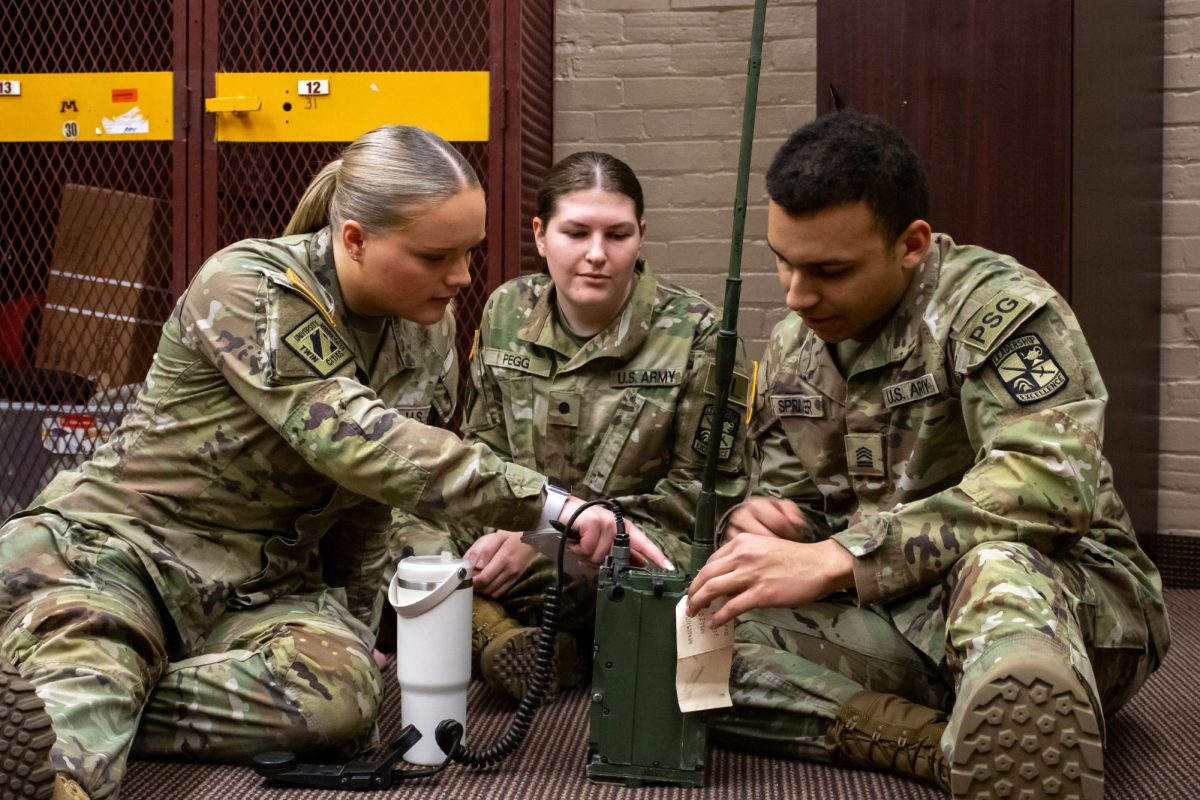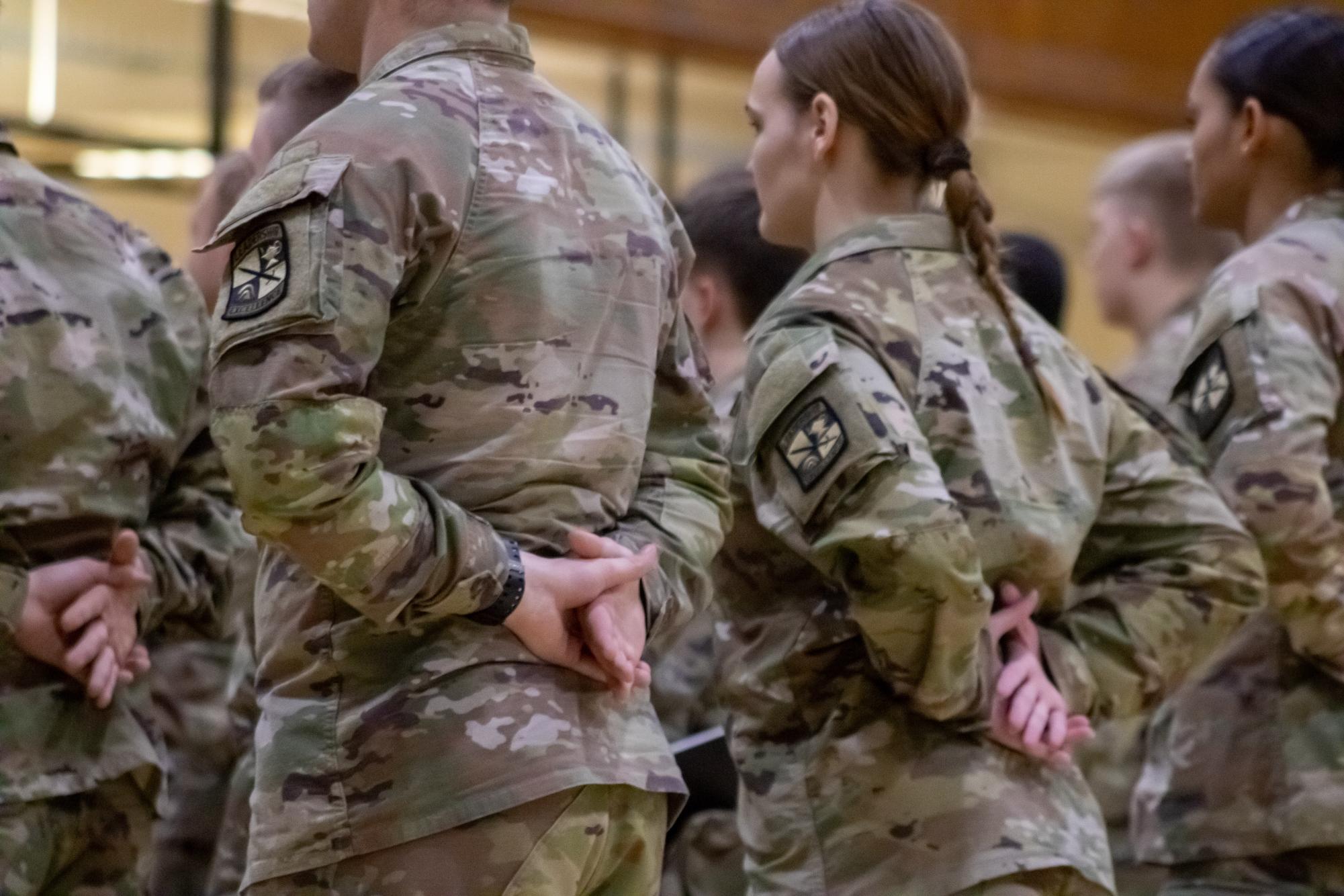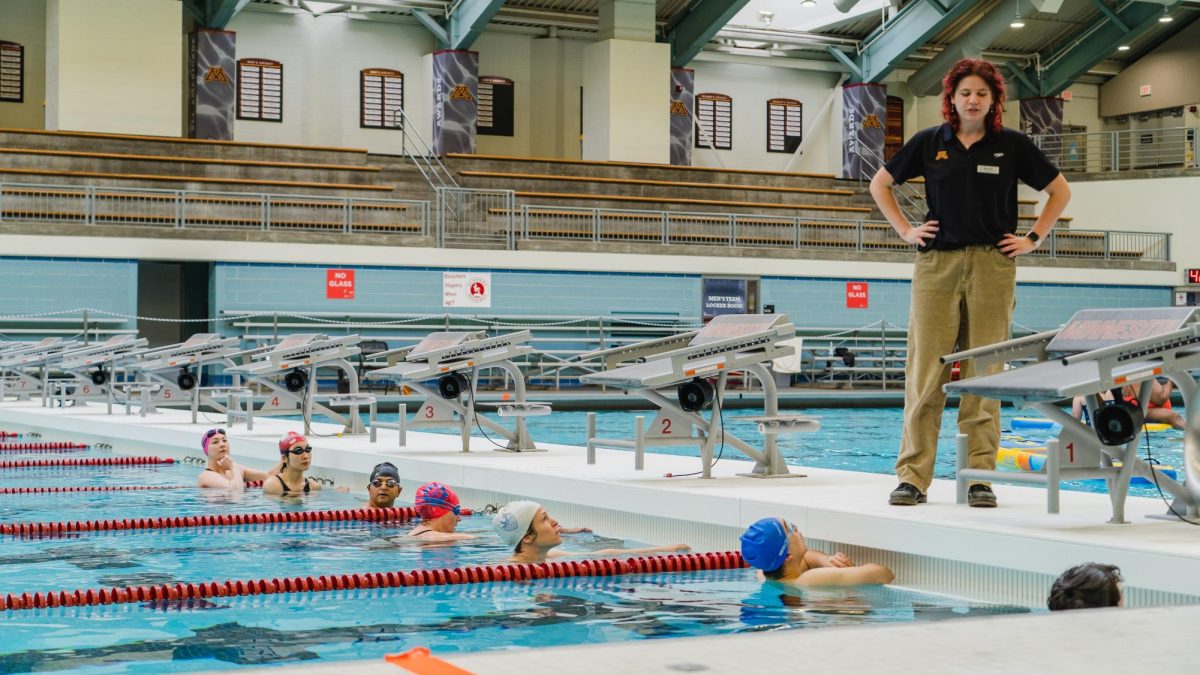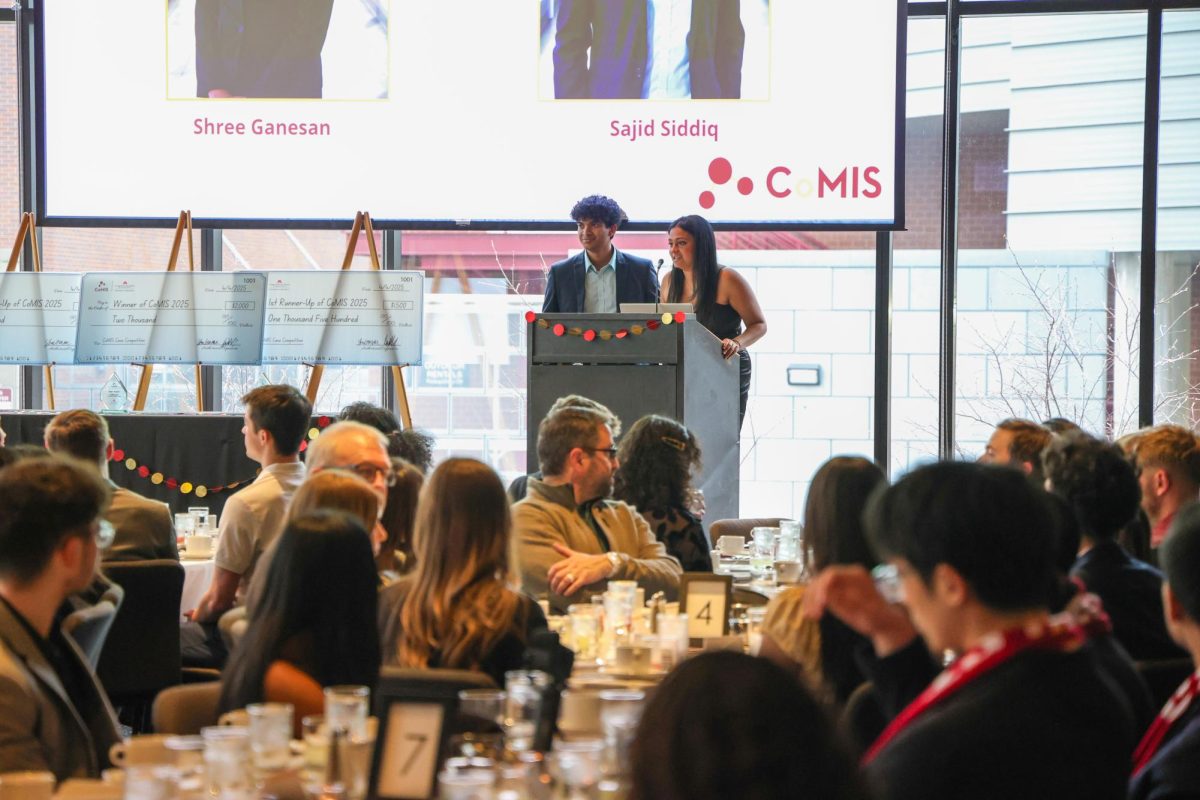The sun had not yet risen when around 200 students gathered on Wednesday, all wearing matching clothes. Standing in rows, they waited with their water bottles at their feet. It was time for physical training, otherwise known as PT.
The Reserve Officer Training Corp (ROTC) cadets flock to the University of Minnesota field house for PT from 6:30 – 7:30 a.m. every Monday, Wednesday and Friday.
In attendance on Wednesday was platoon sergeant Marcus Detloff, a third-year sociology of law, criminology and justice student, who let The Minnesota Daily follow him around for the day to experience what life as a cadet is like.
Wednesday morning’s PT consisted of stretches, sled pulls, burpees, mountain climbers and running with medicine balls. With music blaring and supportive peers, cadets are encouraged to perform to the best of their ability.
At first glance, PT can look intimidating, with the field house filled with matching cadets performing physical tasks. When taking a closer look, you can see leaders demonstrating tasks or participating along with cadets, encouraging them through words or actions.
With PT concluding at 7:30, cadets have half an hour to shower and change into their uniform before military science class from 8 – 9 a.m.
This Wednesday morning, Detloff’s military science class consisted of presentations given by cadets who would be teaching later in the day on topics such as how to read and fill out range cards, what the radio and communicative signals are and why and how to camouflage while in the field.
Military science class teaches cadets to become leaders, with teachers pushing students to test their knowledge and understanding. With a slight cussing and “welcome to the army” attitude, experienced teachers provide tough love.
With three years under his belt, Detloff knows the ROTC program is a structured environment where a person can build themself.
“Military gives you your tasks, conditions, and standards. You’re going to do these things, here’s the standard you’re going to do it to, or here’s how we’re going to teach you to do it that way,” Detloff said. “[ROTC] gives you an environment where you are being graded against your peers.”
After military science class, Detloff has a couple of hours to kill before class at 11 a.m. During this time, he works on homework or ROTC tasks such as taking attendance from morning PT, sorting through forms or making sure everyone is doing what they are supposed to.
Detloff decided to join ROTC because it runs in his family. With a father in active duty in the Air Force, an uncle in the army and both grandfathers having served in the Minnesota National Guard during the Vietnam War, Detloff said it was just the way he was raised.
Beyond providing a stable environment to learn, Detloff appreciates how the military lets people improve themselves.
“You have the ability to prove yourself and your abilities, not only to your peers and superiors but to yourself,” Detloff said.
After his regular class, Detloff had a lab for ROTC at 4:30 p.m., where the presentations seen in military class that morning played out in real time.
Military labs meet ten times per semester and can happen at the Armory or places like Arden Hills or Camp Ripley in Brainerd.
Cadet Gavin Chow, a second-year geography student, said the best thing for new cadets to do is take in the experience and ask questions.
“The army is big on repetition, just kind of ingraining it into your brain,” Chow said in between lab sections. “The more questions you ask, and the more times you hear things, the easier you’ll actually learn.”
Chow’s Wednesday was spent running an “easy six-mile” workout with the challenge team for PT and three classes, including military science, German and geography, followed by a military lab with the rest of the cadets.
“My whole life I kind of always knew I wanted to join the army,” Chow said. “Right now, the plan is to continue with ranger challenge stuff, which is one of our specialty teams, and then I’d like to branch infantry.”
Specialty and ranger challenge teams are premiere soldier skills teams. Some teams include the University’s Army 10 Miler team, which competes in the largest ten-mile road race in the world in Washington D.C.
The Ranger Challenge team, which Chow belongs to, competes against other colleges nationwide in events such as patrolling, marksmanship, weapons assembly, one-rope bridge, hand grenade assault course, Army physical challenging events, land navigation and forced ruck marches of various distances.
Many cadets participate in something other than regular ROTC training, according to Detloff.
While Chow said he participated in ranger challenges, Detloff runs the ROTC’s color guard, which posts the colors for the national anthem for Gopher games and even some games for the Minnesota Vikings and the NCAA Women’s Basketball National Championship.
“You get what you put into it, but there’s a lot of variability,” Detloff said. “You kind of choose your own adventure.”
Chow said the best part of ROTC has been meeting a lot of different people, including students from other schools.
“I think a lot of people are afraid of the military around here and don’t like it,” Chow said. “I, for one, have gotten dirty looks while walking in uniform. I know people who have gotten flipped off.”

What is ROTC?
The purpose of ROTC is to create second lieutenants for the army, according to Staff Sergeant Joseph Hance, who now works as a recruiter for the University’s ROTC program.
Out of all officers in the army, 75% come out of ROTC programs, according to Hance.
“The biggest thing is cadets must earn a degree to be commissioned an officer in the U.S. military,” Hance said. “That is our number one priority here.”
There are 1,300 universities with an Army ROTC program, and 273 of them with a host battalion, like the University. The University is a host battalion for 11 partner schools that come to the Twin Cities campus for the program, including Bethel, St. Kate’s, Hamlin, Metro State and North Central, according to Hance.
Hance added that while first- and second-year students take basic military classes such as Military 101, 102, 201 and 202, the advanced courses start in the last two years of the program.
“That’s where they’re really getting into the heavy training, the leadership, really learning how to be a lieutenant,” Hance said.
At the program’s end, cadets participate in advanced training camp, where they spend 30 days in Fort Knox, Kentucky, to compete for what they will do after graduation.
“Cadets compete for active duty or reserve components on different lists for the branch field that they want to go into,” Hance said.
The obligation after graduation is to serve eight years, with some of those years being active and some as a reserve.
Hance said providing scholarships for participants is a large part of the ROTC program. The program offers 23 different types of scholarships depending on their career plan and whether the cadet wishes to be on active duty, reserve duty, or if the cadet is already enlisted in the army but wants to become an officer.
According to Hance, the University ROTC has just under 200 cadets, with 115 currently in the Minnesota National Guard.
With plans to commission active duty, Detloff said he is shooting for the armor branch where he can work with tanks, though that depends on how he performs at advanced camp in Kentucky.
For now, Detloff will continue to work on his responsibilities as a platoon sergeant in the Gopher Battalion.
“In reality, we’re all the same rank,” Detloff said. “It’s all peer leadership, we’re all fellow cadets. No one’s better than anyone else, we’re here to learn.”


















Jake Rybacheck
Mar 28, 2024 at 10:08 am
Great article. Not sure what the teacher is talking about above. We have plenty of support from our leaders. Stress can’t be avoided, ROTC teaches you to balance and prioritize.
The article does shine a bright light, it’s not for everyone. But everyone I’ve come in contact with wants to genuinely make you better.
Tom Teresi
Feb 10, 2024 at 12:36 pm
I was in the U of M Army ROTC 1961-63. Back then it was no commitment for the first two years. I didn’t commit for my Jr and Sr years. I passed up $50/month and the two year active duty requirement (along with four years of Reserves).
I eventually joined the National Guard and later transfered to an Army Reserver unit (32nd ICC) 1966-72.
In hindsight I shoulld have stayed in the ROTC program. Who knows, maybe I’d be a “Lifer.”
a teacher
Feb 10, 2024 at 7:25 am
I teach here. Every single ROTC student I’ve had in my classes was using the ROTC for economic reasons and showed up to class exhausted and stressed out. All of them were struggling and reported very little support or sympathy from their superiors with regard to academic and mental well-being. I’d have rather read a better balanced article; this reads like propaganda for something that exploits and harms our students.
Sarah
Feb 9, 2024 at 10:15 am
Thank you for the article. The Army is the largest ROTC program at our University but I wish you’d have added at least one more paragraph that referenced the NAVY and MARINE ROTC and the AIR FORCE – SPACE FORCE ROTCs also housed at the Armory. The Armory has hosted ROTCs for more than 100 years and each branch has similar programs and a number of differences which this article didn’t even hint at.